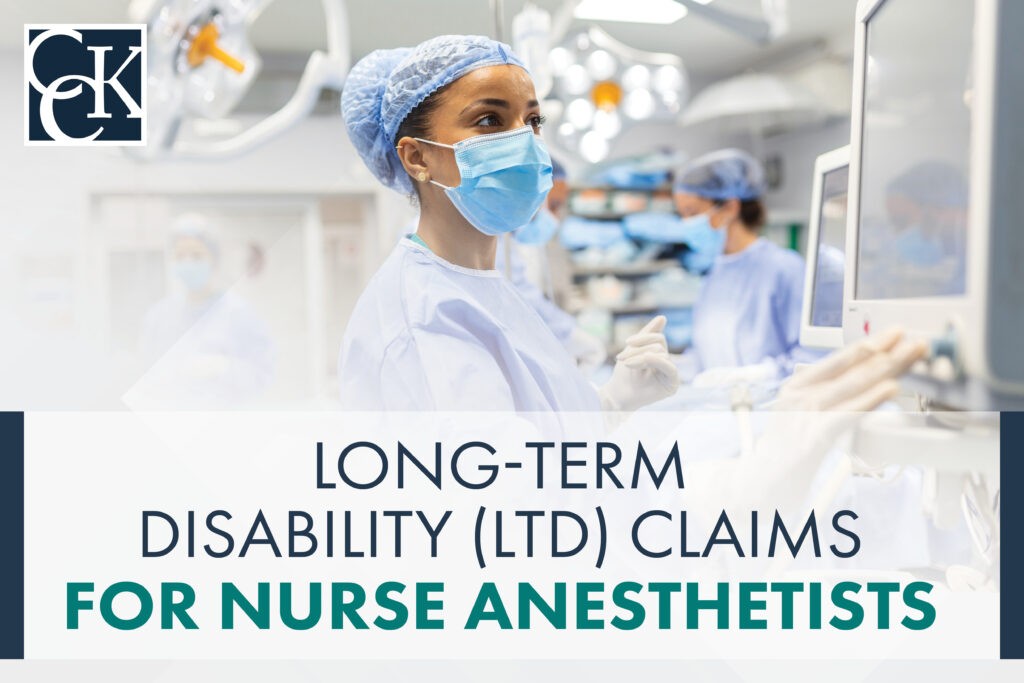Long-Term Disability (LTD) Claims for Nurse Anesthetists

There are as many as 61,000 nurse anesthetists in the United States. They are highly trained health care professionals and perform a sensitive role in medical treatment. Therefore, when a condition interferes with their performance, they may not be able to continue to work.
If you are in this situation, then you should consider your options for long-term disability (LTD) benefits. Many professionals have LTD policies through their employer, if not one that they have purchased themselves.
However, obtaining these benefits is often burdensome for claimants. Nurse anesthetists should be prepared to face several challenges before and after filing for LTD benefits. This can be a difficult process to do alone, especially while dealing with new or worsening disabilities.
You should consider hiring an experienced LTD firm if you wish to maximize the efficiency and potential benefits of your LTD claim. Call CCK today at (800) 544-9144 for a free case evaluation.
What Is “Long-Term Disability” for Nurse Anesthetists?
Nurse anesthetists are medical professionals. They are also frequently called “Certified Registered Nurse Anesthetists” (CRNAs). Their primary focus is on administering pain medication (i.e., anesthesia) during surgery. They also prepare patients beforehand, as well as monitor them after their procedures. This can include giving a physical assessment and monitoring their vitals to ensure they are stable.

Significant time and energy go into becoming a nurse anesthetist. They spend upward of six to eight years studying and gaining knowledge in their field. One way they differ from anesthesiologists is that they are not physicians and have historically had different educational backgrounds. However, beginning in 2025, new nurse anesthetists must acquire a doctoral degree.
Nurse anesthetists may work in a variety of work environments. These environments can include hospitals, dentist offices, military medical facilities, surgical centers, and elsewhere.
Many patients rely on nurse anesthetists to help them through surgeries. Nurse anesthetists may put their patients in danger if they cannot perform the material duties of their job. Such duties may include:
- Administering pain medication
- Assisting physicians, surgeons, and anesthesiologists
- Monitoring patients’ recovery
- Administering epidurals and spinal blocks
- Reviewing patient medical histories to ensure that anesthesia is properly and safely administered
- Discussing all potential side effects with patients
- Monitoring patients after surgery
When nurse anesthetists develop a medical condition that prevents them from performing some or all of their material duties, or they require treatment that interferes with their availability, they may need to stop working to ensure the safety of their patients or their own recovery. If this disruption requires them to take leave of their job, then filing for long-term disability benefits may become necessary to avoid devastating their savings, lifestyle, and financial responsibilities.
How Can Nurse Anesthetists Qualify for Long-Term Disability Benefits?
To qualify for long-term disability benefits, a nurse anesthetist must show their insurer that they have a disability. However, the key terms, definitions, and rules involved may differ by policy. Therefore, it is critical for nurse anesthetists to study their policy before making a claim.
How Nurse Anesthetists Can Find Their LTD Policy
As skilled professionals with high incomes, nurse anesthetists are likely to have an LTD policy. Typically, they received this policy via their employer—a group policy. However, some professionals have bought a policy directly from the insurance company—an individual policy.

All policies have monthly premiums. An employer usually pays all or some of group policy premiums; for individual policies, the professional will pay these premiums themselves. Group policy premiums are typically cheaper, but the coverage under these policies is usually more restricted. For example, a group policy may have several limitations or exclusions, and these cannot be changed. (Some employers may allow employees to add “riders”—e.g., a rider for mental health conditions—for an added fee that the professional would pay themselves. However, this is uncommon.)
Individual policies, on the other hand, are much more flexible, hence their higher premiums. The professional can choose the insurance company, the plan, and the riders. Furthermore, while most group plans are subject to ERISA—a strict federal law that can complicate the LTD process—individual policies are not.
To find out the terms of your group policy, you can inquire with a member of your human resources department. If you believe you may have an individual plan, you can check with your financial institution to see if you are paying monthly premiums. If so, you can contact the insurance company directly.
Once you have found the source of your policy, you should research your policy and request an application.
How to Define “Disability” for Nurse Anesthetist LTD Claims
All policies include a definition of disability. Your condition must meet this definition for you to receive benefits. It is important to read your policy thoroughly to determine your specific coverage.
- “Own occupation”—Many medical professionals will have this type of policy, and the good news is that it is easier to prove. Essentially, being disabled in terms of your own occupation means that you are unable to perform most of the occupational duties that you have been trained to perform.
- Alternatively, you may have an “any occupation” definition, which is much more difficult to prove. You must show that you are unable to perform the material duties of all types of jobs with comparable earnings.
It is important to note that some policies may transition from an “own occupation” to an “any occupation” after a set period—often 24 months. After this time, the insurance company will reevaluate your claim, and if you cannot satisfy the new definition, they can terminate your benefits.

What Types of Evidence Are Commonly Required for LTD Claims?
Claimants must submit objective evidence to prove their claim. Objective evidence can include medical records, vocational evaluations, imaging test results like X-rays or MRIs, blood test results, official diagnoses of conditions, and specialized doctor reports.
It can be invaluable to keep a symptom diary and to keep up with doctor visits. Many insurers require that claimants continue to receive treatment for their condition to receive approval of their claim. If you stop visiting your doctor—for whatever reason—the insurance company may interpret this to mean that you no longer suffer from your condition and therefore do not need benefits.
Your application for benefits is likely to require statements from you, your employer, and your attending doctor. When filling out your application, do not be misled by any short fields. It is critical to provide any useful information.
Why LTD Claims by Nurse Anesthetists Can Be Challenging
Many issues can arise while filing for long-term disability benefits. The LTD process may proceed through three phases: the initial claim, the administrative appeal, and litigation. Of course, claimants want to win an approval during the first stage, but this is not always the reality.

Issues that you may face as a nurse anesthetist filing for long-term disability benefits include:
- The insurance company incessantly asking for more information
- Requests to attend an “independent medical exam” (IME), which is not truly independent since the doctors who perform these exams are paid for by the insurance company
- Surveillance conducted by the insurance company that injects doubt into your claim
- Offsets because of Social Security Disability Insurance benefits, which you are often required to apply for as part of the LTD process
- A waiting period that delays the LTD process and during which you cannot receive long-term disability benefits (short-term disability benefits can help bridge this gap in coverage)
- Delays in the insurance company’s decision due to them filing extensions
- Procedural complications due to ERISA, such as not submitting evidence after the appeal stage and not having a jury during litigation
Claimants can get overwhelmed by the abovementioned issues or commit simple mistakes when they handle their claims alone, such as missing deadlines. If this happens to you, then you are not alone.
How Can Chisholm Chisholm & Kilpatrick Help Nurse Anesthetists Receive Their LTD Benefits?
Despite the challenges, some claimants decide to handle their LTD claims on their own. However, it may be highly beneficial to have an experienced long-term disability attorney assist with your claim.
The LTD team at Chisholm Chisholm & Kilpatrick—one of the most respected public interest firms in the U.S., with over three decades of combined experience—understands how difficult and stressful it is trying to receive benefits, and we want to help. We can:
- Act as a point of contact between you and your insurer
- Track deadlines
- Collect and submit all evidence
- Handle your case at different stages in the process
This is not something you must do alone. Long-term disability benefits are important, and we believe you should not have to worry about getting them.
Call CCK today at (800) 544-9144 for a free case evaluation with a member of our team. We will analyze your claim or appeal and see how we can help.
About the Author
Share this Post

